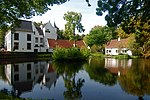's-Gravenambacht
Former municipalities of South HollandSouth Holland geography stubs
's-Gravenambacht is a former hamlet and former municipality in the Dutch province of South Holland. The area is now part of Rotterdam, and almost completely covered by the Eemhaven dockyards. The western part of the village of Heijplaat is also in this area. The municipality existed between 1817 and 1832, when it merged with Pernis.
Excerpt from the Wikipedia article 's-Gravenambacht (License: CC BY-SA 3.0, Authors).'s-Gravenambacht
Bunschotenweg, Rotterdam Charlois
Geographical coordinates (GPS) Address Nearby Places Show on map
Geographical coordinates (GPS)
| Latitude | Longitude |
|---|---|
| N 51.888333333333 ° | E 4.4152777777778 ° |
Address
Bunschotenweg 115
3089 KB Rotterdam, Charlois
South Holland, Netherlands
Open on Google Maps







